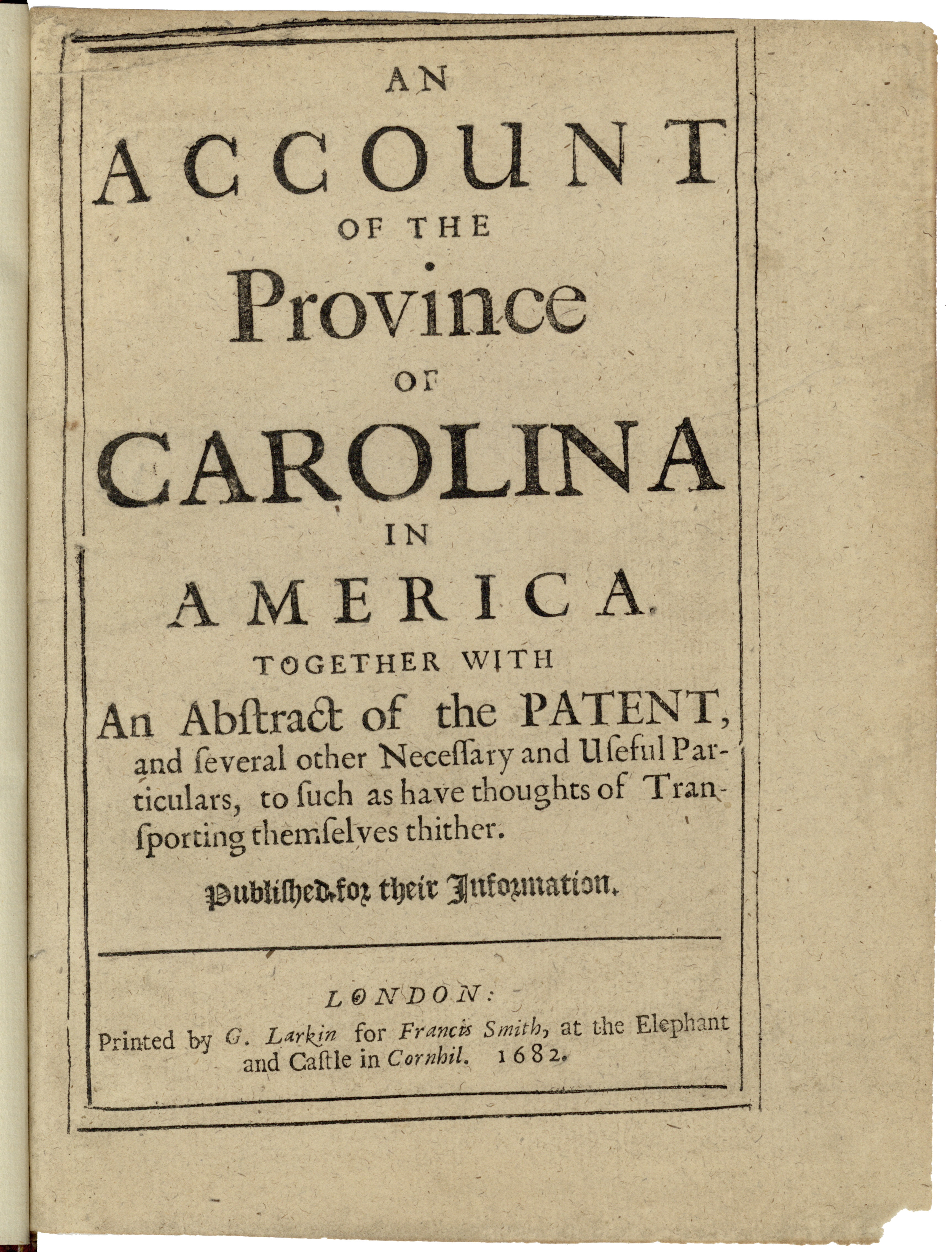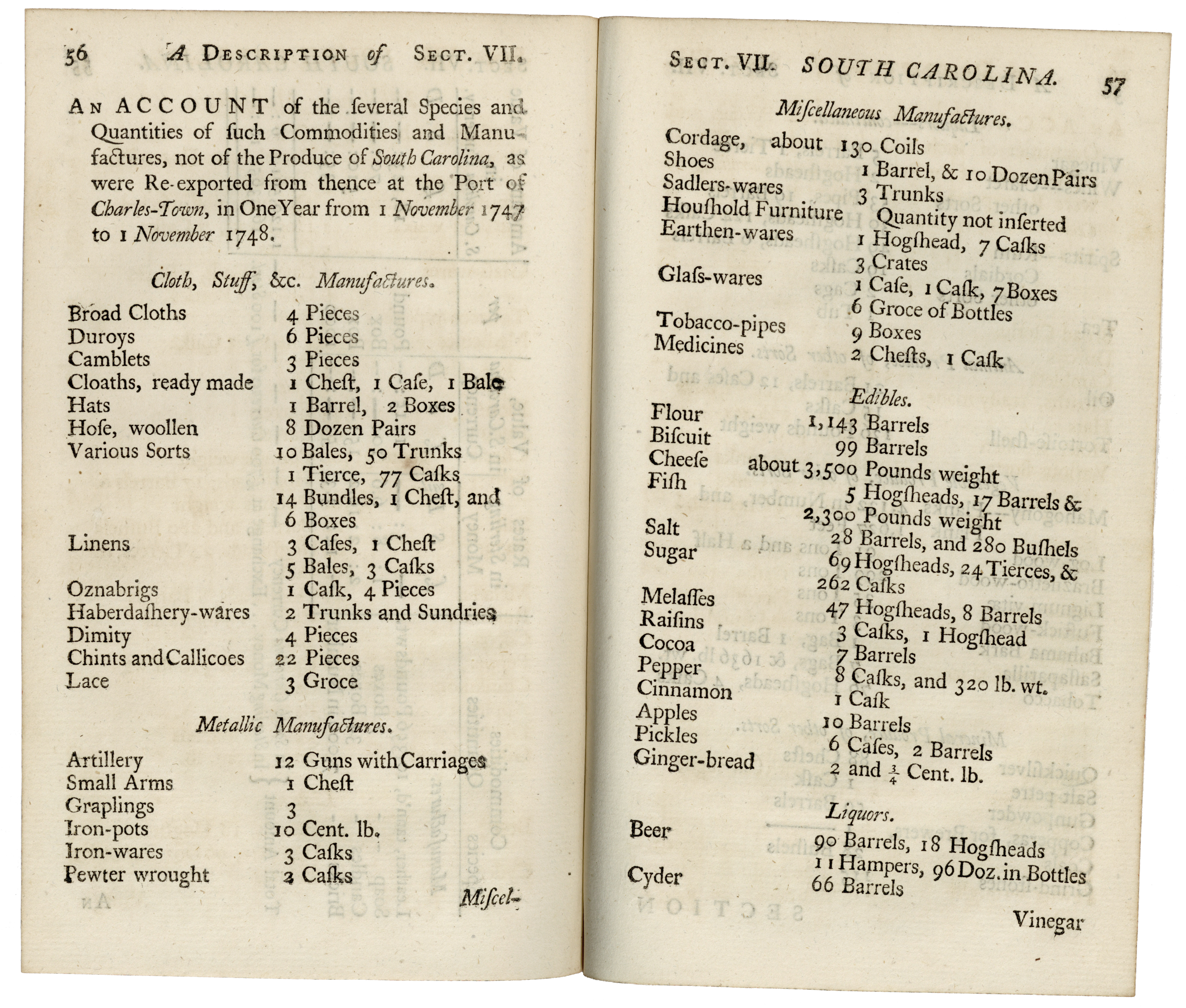
The title page from Wilson’s An Account of the Province of Carolina (ROB139)
‘I have here… described a pleasant and fertile country, abounding in health and pleasure, and with all things necessary for the sustenance of mankind, and wherein I think I have written nothing but truth, sure I am I have inserted no wilful falsehood…’. p.17
In 1663, King Charles II issued a charter granting an extensive expanse of land on the American continent to eight of his political allies, the Lords Proprietors. The territory, the ‘Province of Carolina’, sat between the English colony of Virginia and the Spanish territory of Florida. The first years of settlement were disappointing, but the colony slowly grew, including the settling of Charles Town in 1670. However, the colony continued to face significant difficulties, in particular the lack of new settlers and the failure of the colony to return a profit.
In an attempt to solve these problems, the Lords Proprietors launched a significant promotional campaign in 1682. A major part of this campaign was the commission and publication of promotional tracts that described Carolina and advertised the colony to potential emigrants. One such pamphlet was Samuel Wilson’s An Account of the Province of Carolina in America, published in 1682. Wilson’s account is full of the promise that Carolina offered to those willing to venture there.
Wilson was actually Secretary to the Lords Proprietors, and said that he had written his account ‘as a duty incumbent upon me’, to counter a lack of knowledge of Carolina amongst prospective settlers. However, he was keen to stress his impartiality to readers, claiming that he had ‘most strictly kept to the rules of truth, there not being anything that I have written… which I cannot prove by letters from thence now in my possession, and by living witnesses now in England’. (p.3)
Wilson was keen to show readers that voyaging to Carolina provided an opportunity for the lower sorts to improve their station in life. Wilson claimed that ‘many persons who went to Carolina servants, being industrious since they came out of their times with their masters, have gotten good stocks of cattle, and servants of their own… are now worth several hundreds of pounds, and live in a very plentiful condition’. (pp.7-8). Here we see Carolina portrayed as a land of opportunity, in language similar to the ‘American Dream’ in centuries to come.

A list of commodities traded and sold in the colony, from James Glen’s A Description of Carolina, 1761 (ROB135)
The pamphlet also made some interesting observations (and bold claims) about the environment of Carolina. According to Wilson, the very air of Carolina gave ‘a strong appetite and quick digestion, nor is it withal suitable effects, men finding themselves apparently more lightsome, more prone, and more able to youthful exercises, than in England’. He also claimed that ‘an ox is raised at almost as little expense in Carolina, as a hen is in England’. (p.13)
Wilson argued that the mild winters in the colony meant that ‘the December and January of Ashley River, I suppose to be of the same temperature with the latter end of March, and beginning of April in England’. (p.9) The mild winters also had benefits for those of his countrymen who aspired to be slaveholders, with Wilson claiming that ‘Negroes, by reason of the mildness of the winter thrive and stand much better, than in any of the more northern colonies, and require less clothes, which is a great charge saved’. (p.14) South Carolina went on to have one of the highest slave populations of the British colonies in North America, and later became one of the largest slave-owning states in the U.S.
For those readers who had been persuaded by his account, Wilson advised that ‘the passage of a man or woman to Carolina is five pound, ships are going thither all times of the year’. For those that perhaps needed a little more persuasion or had any questions, they only had to head to the Carolina Coffee House in London, where ‘some of the Lords Proprietors, or myself, will be every Tuesday at 11 of the clock’ (p.19).
Although it is unknown how many people Wilson’s pamphlet in itself inspired to emigrate to Carolina, the promotional campaign of 1682 was a success, resulting in over 500 new settlers to the colony in the next few years. Although accounts like Wilson’s may have over exaggerated the benefits and played down the dangers, these texts played a key role in explaining why so many men and women made the decision to become colonists in the New World.
———————————————————————————————————
If you are interested in reading more about the settlement of Carolina, and descriptions of the colony throughout the colonial period, we have several items here in our collections:
- Samuel Wilson, An Account of the Province of Carolina in America (1682) Robinson 139
- John Lawson, A New Voyage to Carolina (1709) Rare Books RB917.56 LAW
- Thomas Nairne, A Letter from South Carolina (1718) Robinson 41
- James Oglethorpe, A New and Accurate Account of the Provinces of South Carolina and Georgia (1732) Robinson 163
- James Glen, A Description of Carolina (1761) Robinson 135
- George Milligen Johnston, A Short Description of the Province of South-Carolina (1770) Robinson 53
